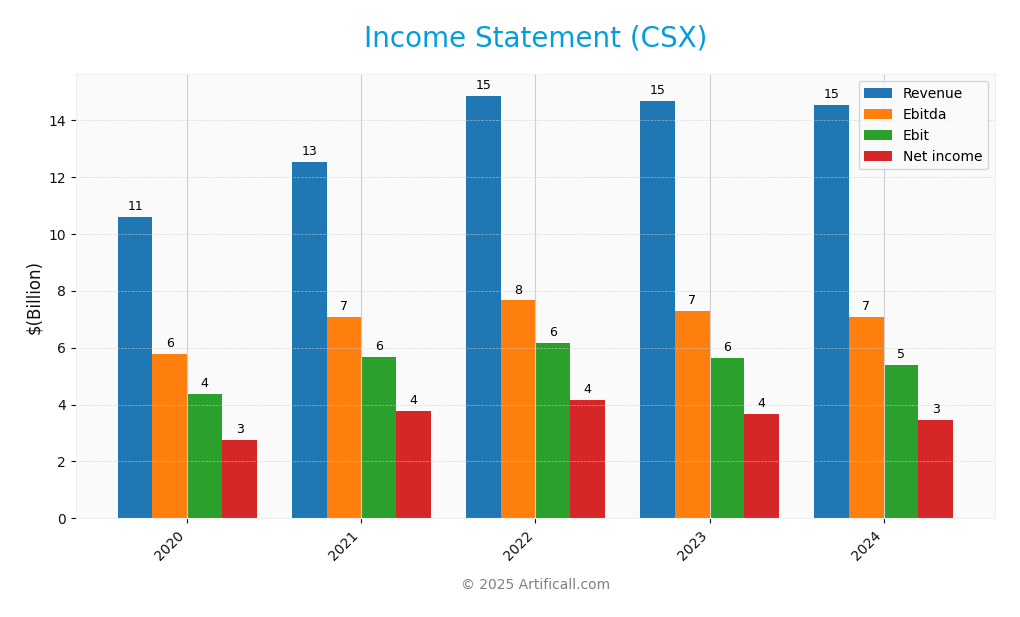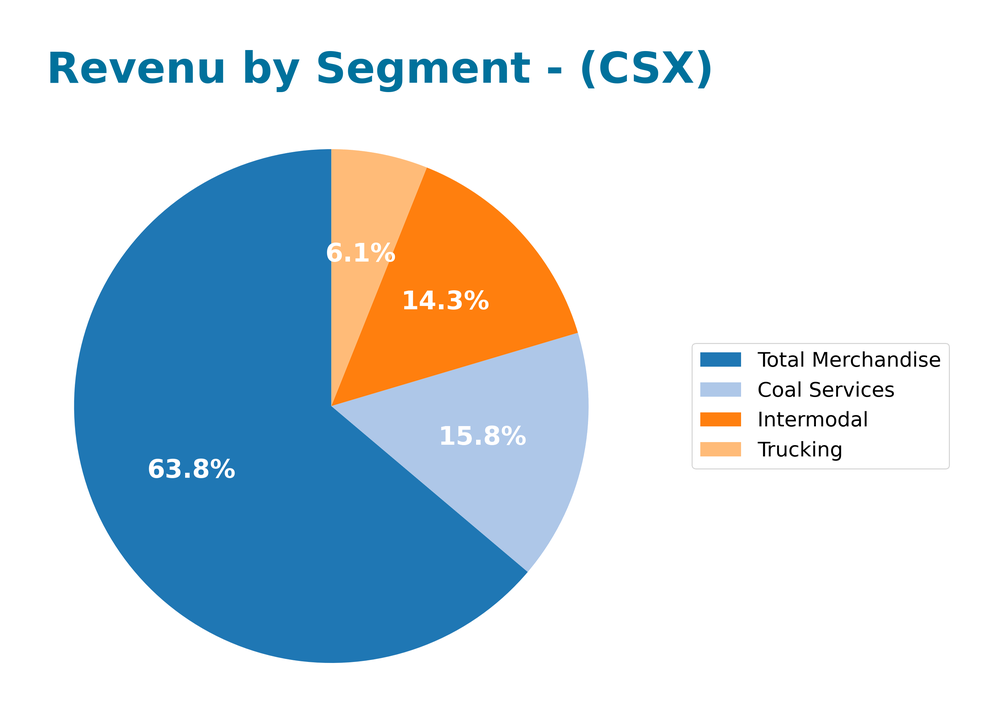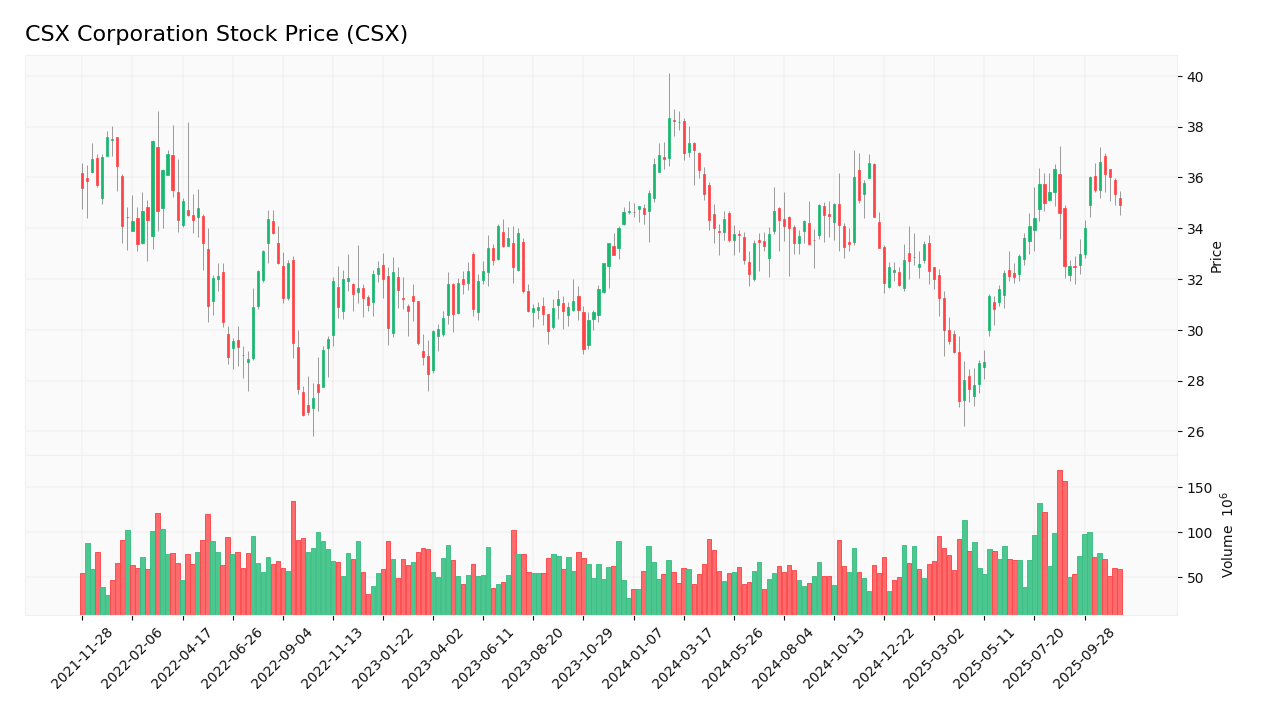CSX Corporation doesn’t just transport goods; it fuels the economy by seamlessly connecting industries through its expansive rail network. As a cornerstone in the rail transportation sector, CSX is renowned for its innovative logistics solutions and quality service, moving everything from automotive parts to bulk commodities across a 19,500-mile network. With its strong market presence and commitment to efficiency, the question arises: do CSX’s robust fundamentals and growth potential still justify its current market valuation?

Table of contents
Company Description
CSX Corporation, founded in 1978 and headquartered in Jacksonville, Florida, is a prominent player in the rail transportation industry. With a robust network of approximately 19,500 route miles, CSX offers rail-based freight services across 23 U.S. states, the District of Columbia, and parts of Canada. The company specializes in the transportation of a diverse range of goods, including chemicals, agricultural products, and automotive parts, alongside providing intermodal services that enhance logistical efficiency. Employing around 23,400 people, CSX is strategically positioned to facilitate critical supply chains while championing sustainability initiatives in the transportation sector. Its commitment to innovation and operational excellence solidifies its role as a leader in shaping the future of freight transportation.
Fundamental Analysis
In this section, I will analyze CSX Corporation’s fundamental aspects, focusing on its income statement, financial ratios, and dividend payout policy.
Income Statement
The following table summarizes CSX Corporation’s income statement for the last five fiscal years, highlighting key financial metrics that investors should consider.

| Metrics | 2020 | 2021 | 2022 | 2023 | 2024 |
|---|---|---|---|---|---|
| Revenue | 10.58B | 12.52B | 14.85B | 14.66B | 14.54B |
| Cost of Revenue | 6.14B | 7.23B | 8.93B | 9.05B | 9.03B |
| Operating Expenses | 1.07B | 1.30B | 1.43B | 1.36B | 1.40B |
| Gross Profit | 4.44B | 5.29B | 5.93B | 5.60B | 5.51B |
| EBITDA | 5.76B | 7.09B | 7.66B | 7.27B | 7.07B |
| EBIT | 4.38B | 5.67B | 6.16B | 5.64B | 5.39B |
| Interest Expense | 754M | 722M | 742M | 809M | 832M |
| Net Income | 2.77B | 3.78B | 4.17B | 3.67B | 3.47B |
| EPS | 1.20 | 1.68 | 1.95 | 1.85 | 1.79 |
| Filing Date | 2021-02-10 | 2022-02-16 | 2023-02-15 | 2024-02-14 | 2025-02-27 |
In analyzing CSX Corporation’s income statement, I observe a slight decline in revenue over the last two years, from 14.85B in 2022 to 14.54B in 2024. This trend is accompanied by a decrease in net income, which dropped from 4.17B in 2022 to 3.47B in 2024. The gross profit margin has remained stable, indicating consistent cost management despite the revenue decline. Specifically, the 2024 performance reflects a challenging year, with EBITDA and EBIT also showing slight reductions. Investors should approach CSX with caution, as the recent performance suggests potential headwinds in revenue growth and profitability.
Financial Ratios
The table below summarizes the financial ratios for CSX Corporation over the last five years, allowing for an easy comparison of its financial performance.
| Ratios | 2020 | 2021 | 2022 | 2023 | 2024 |
|---|---|---|---|---|---|
| Net Margin | 26.1% | 30.2% | 28.0% | 25.0% | 23.9% |
| ROE | 12.6% | 14.8% | 15.3% | 14.5% | 12.7% |
| ROIC | 8.3% | 10.2% | 10.5% | 10.0% | 9.4% |
| P/E | 25.1 | 22.4 | 15.9 | 19.0 | 18.0 |
| P/B | 5.3 | 6.3 | 5.2 | 5.8 | 5.0 |
| Current Ratio | 2.20 | 1.73 | 1.56 | 1.04 | 0.86 |
| Quick Ratio | 2.05 | 1.58 | 1.42 | 0.91 | 0.73 |
| D/E | 1.31 | 1.25 | 1.47 | 1.59 | 1.52 |
| Debt-to-Assets | 43.1% | 41.6% | 44.2% | 45.1% | 44.4% |
| Interest Coverage | 5.7 | 7.1 | 7.8 | 6.8 | 6.4 |
| Asset Turnover | 0.27 | 0.31 | 0.35 | 0.35 | 0.34 |
| Fixed Asset Turnover | 0.32 | 0.37 | 0.43 | 0.42 | 0.40 |
| Dividend Yield | 1.15% | 0.99% | 1.29% | 1.27% | 1.49% |
Interpretation of Financial Ratios
In 2024, CSX exhibits a net margin of 23.9%, which is a decline from previous years, indicating potential concerns regarding profitability. The P/E ratio of 18.0 suggests the stock is fairly valued compared to its earnings, while the current ratio of 0.86 raises liquidity concerns. Overall, while some ratios remain solid, the downward trend in margins and liquidity ratios could signal risks for investors.
Evolution of Financial Ratios
Over the past five years, CSX’s financial ratios have shown a mixed trend. While net margin and return on equity have decreased, the P/E and debt ratios have remained relatively stable. The current ratio has notably declined, indicating a tightening liquidity position, which warrants caution for potential investors.
Distribution Policy
CSX Corporation maintains a balanced approach to shareholder returns, offering a dividend of $0.48 per share, which corresponds to a yield of approximately 1.49%. With a payout ratio of 26.8%, the company demonstrates a sustainable distribution strategy supported by strong free cash flow. Additionally, CSX engages in share buybacks, enhancing shareholder value. However, investors should remain cautious of potential risks associated with overly aggressive repurchases in fluctuating market conditions. Overall, CSX’s distribution policy aligns well with long-term value creation for shareholders.
Sector Analysis
CSX Corporation operates in the railroads industry, providing vital freight transportation services across a vast network. Its competitive advantages include a strong market presence, diversified service offerings, and a strategic focus on intermodal transportation.
Strategic Positioning
CSX Corporation holds a significant position in the rail transportation industry, with a market cap of approximately $65B. The company boasts a robust network of 19,500 route miles, primarily serving the eastern U.S. and parts of Canada. Despite competitive pressure from other transportation modes, CSX maintains a strong market share, particularly in intermodal and bulk commodity transport. However, technological disruptions, such as advancements in logistics and alternative transport systems, pose ongoing challenges. I recommend monitoring these dynamics closely to assess potential impacts on CSX’s market position and performance.
Revenue by Segment
The following chart illustrates the revenue distribution across various segments for CSX Corporation for the fiscal year ending December 31, 2024.

In 2024, CSX’s revenue distribution shows a notable emphasis on the Total Merchandise segment, which generated 8.9B. The Coal Services segment contributed 2.2B, while Intermodal accounted for 2B. Compared to the previous year, the Total Merchandise segment saw growth, suggesting a strong demand across multiple product lines. However, the Coal Services segment declined from 2.5B in 2023, indicating potential market shifts or increased competition that may pose margin risks moving forward. As growth dynamics evolve, investors should monitor these segments closely for signs of recovery or further decline.
Key Products
CSX Corporation offers a diverse range of rail-based freight transportation services that cater to various industries. Below is a table summarizing the key products offered by CSX:
| Product | Description |
|---|---|
| Rail Freight Services | Provides transportation of bulk commodities, including chemicals, agricultural products, and minerals. |
| Intermodal Transportation | Offers services for transporting intermodal containers and trailers, linking rail and truck services. |
| Automotive Logistics | Facilitates the movement and storage of automotive parts and finished vehicles across its rail network. |
| Drayage Services | Provides pickup and delivery of intermodal shipments, ensuring efficient transfers from rail to truck. |
| Coal Transportation | Transports coal to power plants and exports it to deep-water port facilities, serving energy needs. |
| Forest Products Shipping | Handles the logistics of transporting lumber and other forest products to distribution centers. |
By understanding these key products, investors can better appreciate CSX’s operational scope and its potential impact on revenue and growth.
Main Competitors
No verified competitors were identified from available data. CSX Corporation, a prominent player in the railroads industry, holds an estimated market share that reflects its strong competitive position. The company operates a vast rail network and offers diverse transportation services, establishing itself as a key provider in the North American freight transportation sector.
Competitive Advantages
CSX Corporation boasts a robust rail network of approximately 19,500 route miles, providing essential transportation services across 23 states and into Canada. This extensive reach allows CSX to capitalize on the growing demand for efficient freight transport, particularly for intermodal and bulk commodity operations. Looking ahead, opportunities in emerging markets and the potential expansion of sustainable transportation solutions could further enhance its competitive edge. The ongoing investment in technology and infrastructure will likely position CSX favorably as industries seek reliable logistics partners in a rapidly evolving economic landscape.
SWOT Analysis
This SWOT analysis aims to provide a clear overview of CSX Corporation’s strengths, weaknesses, opportunities, and threats to inform strategic decision-making.
Strengths
- Strong market position
- Extensive rail network
- Diverse service offerings
Weaknesses
- High operating costs
- Dependence on economic cycles
- Regulatory challenges
Opportunities
- Growth in intermodal transport
- Expansion into new markets
- Increasing demand for freight services
Threats
- Competition from other transport modes
- Economic downturns
- Regulatory changes
The overall SWOT assessment indicates that while CSX Corporation has significant strengths and opportunities for growth, it must navigate its weaknesses and external threats effectively. This balance will be crucial in shaping a resilient and adaptable business strategy.
Stock Analysis
Over the past year, CSX Corporation’s stock has experienced notable price movements, reflecting key trading dynamics that warrant close examination.

Trend Analysis
Analyzing CSX’s stock trend over the past year, the percentage change is +0.78%. This indicates a neutral trend since the change falls between -2% and +2%. The stock has seen a highest price of 38.33 and a lowest price of 27.21, suggesting a range of volatility, with a standard deviation of 2.29. Notably, the trend reflects acceleration, indicating that the price movements may be gaining momentum in the current market context.
Volume Analysis
In the last three months, CSX has witnessed an average trading volume of approximately 76.77M shares. The volume shows a seller-dominant activity, with average sell volume at 43.55M compared to average buy volume of 33.22M. This leads to a decreasing trend in volume, suggesting that investor sentiment may be leaning towards caution, with market participation being relatively subdued.
Analyst Opinions
Recent analyst recommendations for CSX Corporation indicate a strong consensus towards a “buy” rating. Analysts highlight the company’s solid fundamentals, including a robust return on equity (5) and return on assets (5), which signal efficient management and profitability. Notably, the rating from FMP is an “A-“, reflecting confidence in CSX’s growth potential. While the price-to-earnings and price-to-book scores suggest some caution, the low debt-to-equity ratio (1) reassures investors about financial stability. Overall, I see a favorable outlook for CSX this year.
Stock Grades
CSX Corporation has recently received several grades from reputable grading companies, indicating a consistent outlook among analysts.
| Grading Company | Action | New Grade | Date |
|---|---|---|---|
| Baird | Maintain | Outperform | 2025-10-20 |
| JP Morgan | Maintain | Overweight | 2025-10-20 |
| Barclays | Maintain | Overweight | 2025-10-20 |
| Jefferies | Maintain | Buy | 2025-10-17 |
| TD Cowen | Maintain | Buy | 2025-10-17 |
| Evercore ISI Group | Maintain | Outperform | 2025-10-17 |
| Raymond James | Maintain | Outperform | 2025-10-17 |
| UBS | Maintain | Buy | 2025-10-17 |
| Citigroup | Maintain | Buy | 2025-10-13 |
| JP Morgan | Maintain | Overweight | 2025-10-08 |
Overall, the trend in grades for CSX indicates a strong confidence among analysts, with multiple firms maintaining positive ratings such as “Buy” and “Outperform.” This suggests that CSX is considered a solid investment option in the current market climate.
Target Prices
The consensus target price for CSX Corporation reflects a range of expectations from analysts.
| Target High | Target Low | Consensus |
|---|---|---|
| 45 | 34 | 39.86 |
Overall, analysts anticipate CSX’s stock to reach around 39.86, suggesting a balanced outlook with potential for growth.
Consumer Opinions
Consumer sentiment toward CSX Corporation reveals a mixed bag of experiences, showcasing both appreciation and criticism from its users.
| Positive Reviews | Negative Reviews |
|---|---|
| “Reliable service with timely deliveries.” | “Customer service could use significant improvement.” |
| “Consistent performance and competitive pricing.” | “Frequent delays in shipments during peak times.” |
| “Strong commitment to sustainability initiatives.” | “Issues with damaged goods during transit.” |
Overall, consumer feedback indicates that CSX excels in reliability and sustainability efforts but faces challenges with customer service and shipment delays.
Risk Analysis
In this section, I outline key risks associated with investing in CSX Corporation, helping you make informed decisions.
| Category | Description | Probability | Impact |
|---|---|---|---|
| Market Volatility | Fluctuations in transportation demand impacting revenues. | High | High |
| Regulatory Changes | Changes in environmental regulations affecting operations. | Medium | High |
| Operational Risks | Disruptions due to accidents or infrastructure failures. | Medium | Medium |
| Competition | Increased competition from other transportation companies. | High | Medium |
| Economic Downturn | Recession may reduce freight volumes and profitability. | Medium | High |
Given the current trends, market volatility and regulatory changes are the most significant risks for CSX Corporation, as they can severely affect profitability and operational stability.
Should You Buy CSX Corporation?
CSX Corporation boasts a strong net profit margin of 23.87% and a favorable return on invested capital (ROIC) of 7.59%, exceeding its weighted average cost of capital (WACC) of 8.44%. The company has a robust competitive position due to its extensive rail network, but it faces risks from increased competition and potential disruptions in the supply chain.
Given the positive net margin and the fact that ROIC is greater than WACC, along with a favorable long-term trend and sufficient buyer volumes, the outlook for CSX appears favorable for long-term investors. However, I would advise monitoring the stock closely as seller volumes remain dominant in the recent trend, suggesting it may be prudent to wait for a more favorable buying environment before making a significant investment.
Specific risks include heightened competition in the transportation industry, potential supply chain disruptions, and overall market dependence on economic conditions.
Disclaimer: This article is not financial advice. Each investor is responsible for their own investment decisions.
Additional Resources
- Service with Purpose – CSX.com (Aug 28, 2025)
- Westgate Super Site Receives CSX Select Site Platinum Designation – GlobeNewswire (Nov 12, 2025)
- CSX Corporation: Benefiting From A Merger Environment (CSX) – Seeking Alpha (Oct 23, 2025)
- CSX Corporation stock prediction for this week – Earnings Miss & High Return Trade Opportunity Guides – newser.com (Nov 14, 2025)
- Rathbones Group PLC Sells 7,431 Shares of CSX Corporation $CSX – MarketBeat (Nov 11, 2025)
For more information about CSX Corporation, please visit the official website: csx.com



